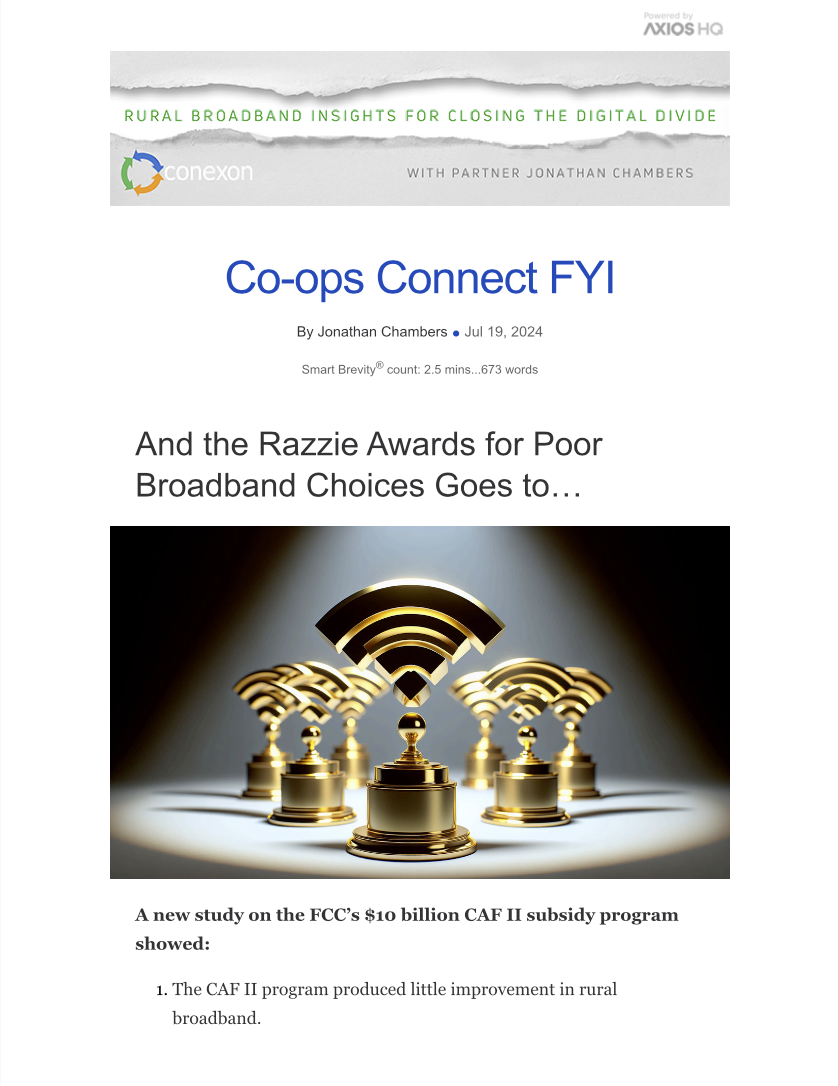And the Razzie Awards for Poor Broadband Choices Goes to…
July 19, 2024
A new study on the FCC’s $10 billion CAF II subsidy program showed:
- The CAF II program produced little improvement in rural broadband.
- The recipients of the massive subsidies – telephone companies – stopped offering any internet service to half the locations a few years after the funding ended.
(Read more about the study here)
In other words, the $10 billion produced little to no infrastructure. The money is gone, and the service offerings have largely ended.
I was bitterly opposed to this program when I was at the FCC. Its outcome was so predictable at the time, one had to be willfully blind not to see it.
If there were Raspberry Awards for government waste, the CAF II program might win the Razzie award.
Below are my candidates for the most egregious government decisions (mistakes) in rural broadband programs in recent years – all of which have done more to harm than help rural America’s access to broadband.
The Broadband Razzies Top 10

1) The aforementioned CAF II Connect America Cost Model program.
2) The FCC Alternative Connect America Model programs (ACAM, ACAM II, Enhanced ACAM), which have devoted tens of billions of non-competitively bid public dollars to small telephone companies for a quality of “broadband” service that is not even considered broadband by the very agency doling out the dollars.
3) The failure of the FCC to properly vet bidders before the RDOF auction, leading to defaults by several of the largest winning bidders and at least half the funding, and then compounding that failure by not having a mechanism to reward funds to a next-in-line bidder.
4) The failure of the FCC to account for the known technical limitations of fixed wireless systems, resulting in most fixed wireless bidders in the CAF II and RDOF auctions defaulting or in the process of defaulting.
5) NTIA’s series of decisions to increase the cost of broadband construction by at least 25% to areas that are, by definition, high-cost, thereby adding additional inflationary pressures to the rural broadband industry. How does the U.S. Department of Commerce not understand the correlation between the additional cost of production and consumer inflation?
6) Squandering $14 billion on the Affordable Connectivity Program without a plan to make the program sustainable, thereby ending the program before the BEAD rural program had even begun.
7) Delaying implementation of the BEAD allocation for over 18 months, ostensibly to wait for the FCC to produce a broadband map that was not even intended to count the very thing (un/underserved and unfunded locations) that BEAD will fund. (As a codicil, for Treasury, Commerce, and state agencies to rely on broadband maps that are not even relied upon by the very agency that produces the maps.)
8) Requiring environmental assessments for existing infrastructure — but only for the BEAD program, not any other federal program.
9) Seeking Letters of Credit from BEAD applicants, a program that reimburses companies after construction is complete. In other words, companies must get letters of credit for spending their own money. It is so absurd, I can’t even…
The Author’s Choice Award

And the ‘winner’ … or my own top choice for the coveted Razzie Award is …
10) NTIA’s design of BEAD.
- The program design created the strongest possible disincentive to build rural broadband networks in unserved and underserved areas.
- And then, the program has been delayed with administrative folderol for three years, so those most in need wait the longest.
- Even a simple look-back provision for construction to unserved and underserved locations would have accelerated construction to millions of rural homes.
The last word:
I wrote this list in ten minutes. I could write another ten just as easily. But I’m sure I am missing more Razzie contenders.
Send in your nominations – I’d love to hear from you.
